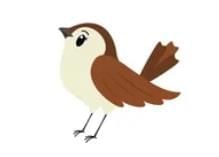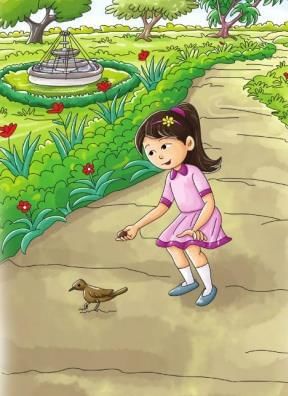Summary: A Bird, Came Down the Walk | English Class 4 ICSE PDF Download
| Table of contents |

|
| Introduction |

|
| Key Points of the Poem |

|
| Summary |

|
| Message |

|
Introduction
"A Bird, Came Down the Walk" is a beautiful poem by Emily Dickinson. It describes a small bird's actions as seen by someone watching quietly. The poem uses simple words to show the bird's natural behavior, like eating, drinking, and moving carefully. It also teaches us to be kind to animals and notice the little things in nature. This poem helps us appreciate the beauty of everyday moments in the world around us.

Key Points of the Poem
- The poem tells the story of a small bird and its daily actions.
- It shows how the bird eats, drinks, and moves in a natural way.
- The poem also shows a kind act by a person towards the bird.
- It teaches us to watch nature closely and be gentle with animals.
Summary
Stanza 1
A bird, came down the walk
He did not know I saw
He bit an angle worm in halves
And ate the fellow, raw,
This stanza tells us that a bird is walking along a path, not knowing that someone is watching it. The bird finds an earthworm, which is a small creature that lives in the soil. It bites the worm into two pieces and eats it without cooking it. This shows how birds naturally find and eat their food in the wild.
Stanza 2
And then, he drank a dew
From a convenient grass
And then hopped sidewise to the wall
To let a beetle pass
This stanza explains that after eating, the bird drinks water drops, called dew, from a blade of grass that is close by. Then, the bird hops to the side near a wall to make space for a beetle, which is a small insect, to pass by. This shows that the bird is careful and polite, making sure it doesn't disturb other creatures.

Stanza 3
He glanced with rapid eyes,
That hurried all abroad
They looked like frightened beads, I thought,
He stirred his velvet head.
This stanza describes how the bird looks around quickly with its eyes, which move fast in all directions. The eyes look shiny and scared, like little beads. The bird also moves its soft, smooth head a little bit. This tells us that the bird is always alert and careful, checking for any danger around it.
Stanza 4
Like one in danger, cautious,
I offered him a crumb,
And he unrolled his feathers,
And rowed" him softer home.
This stanza tells us that the person watching the bird feels careful, just like the bird, and offers it a tiny piece of bread, called a crumb. The bird spreads its feathers and flies away gently, as if rowing through the air. This shows how the bird responds to the kind act and flies back home in a soft and peaceful way.
Message
The poem teaches us to observe the beauty of nature and the little things animals do. It also encourages us to be kind and careful with animals, showing that even a small act like offering food can make a difference.
New Words with Meanings
- Angle worm: Another name for an earthworm, which lives in the soil.
- Convenient: Something that is easy to reach or use because it is nearby.
- Stirred: Moved a little bit, like a small shake or turn.
- Cautious: Being very careful to avoid any danger or trouble.
- Crumb: A tiny piece of bread or food that has broken off.
- Rowed: In this poem, it means the bird flew away gently.
FAQs on Summary: A Bird, Came Down the Walk - English Class 4 ICSE
| 1. What are the main themes explored in the poem "A Bird, Came Down the Walk"? |  |
| 2. How does the poet use imagery to enhance the poem's meaning? |  |
| 3. What literary devices are utilized in "A Bird, Came Down the Walk"? |  |
| 4. What message does the poem convey about nature and humanity? |  |
| 5. How does the structure of the poem contribute to its overall impact? |  |



















